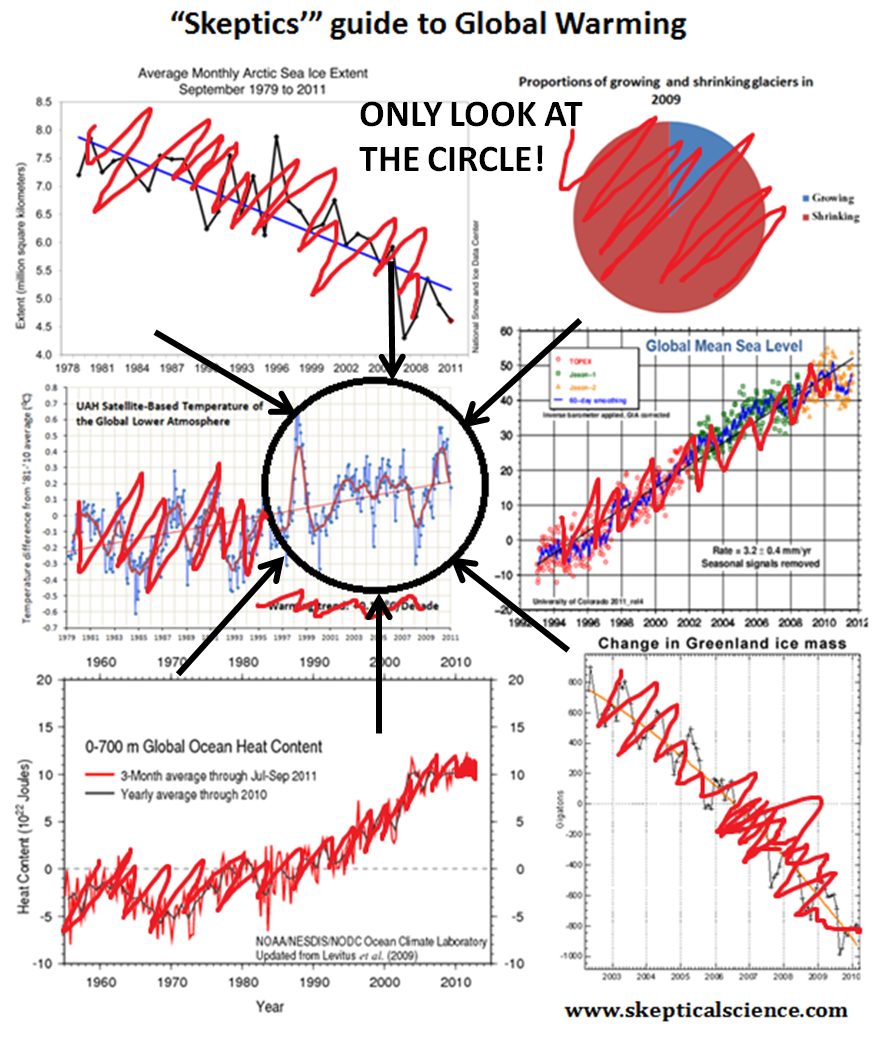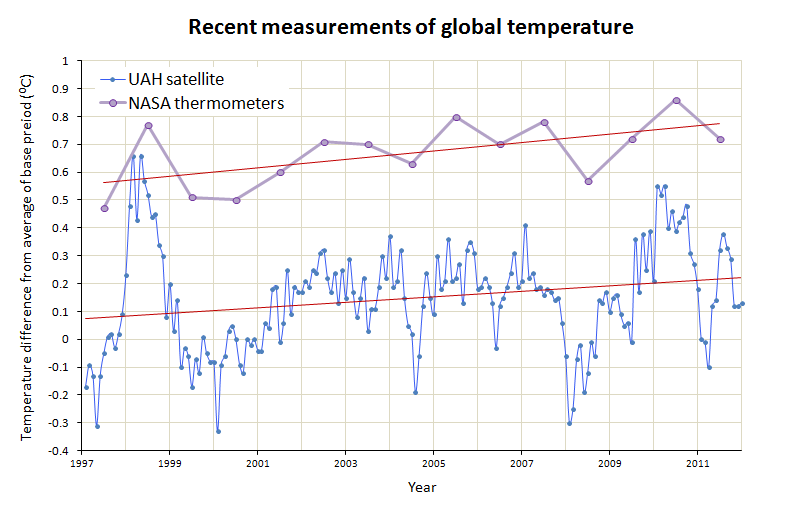Measurements show Earth heating up, think tanks & newspapers disagree
Posted on 2 February 2012 by MarkR
The Global Warming Policy Foundation (GWPF) is a British political think tank that attacks climate science. Its commentary is often regurgitated by journalists at newspapers with similar political opinions on climate science such as the Daily Mail, Express and Telegraph (whose consulting science editor is a GWPF adviser).
The Daily Mail recently published an article covering two bits of science news. One is that the UK Met Office and their partners are updating their global temperature data and including more measurements from Russia and around the Arctic. The data aren't publicly available yet, but graphs from a Met Office presentation suggest that 2005 and 2010 could be warmer than the previous record holder (1998), bringing the British data into agreement with NASA and the National Climatic Data Centre.
The other bit of science news is research on how the Sun is expected to cool down slightly in the coming decades. "The likely reduction in the warming by 2100 is found to be between 0.06 and 0.1K" (Jones, Lockwood & Stott, 2012), much less than the 0.17 C warming per decade measured since the 1970s (1 K is the same size as 1 degree Celsius).
Gareth Jones, the climate science expert who led the Met Office research said "this research shows that the most likely change in the Sun's output will not have a big impact on global temperatures or do much to slow the warming we expect from greenhouse gases."
The Daily Mail's interpretation is the opposite of what the scientists reported, and dutifully parrots GWPF talking points. The article claims we're possibly heading for a "mini ice age", that there has been "no warming for 15 years" and quotes the GWPF's Benny Peiser's prophecies of doom for climate models.
The data the Global Warming Policy Foundation won't want you to see
In the past 15 years the upper 700 metres of the ocean have gained the amount of heat that would be released by around 1 billion Hiroshima bombs exploding. Hundreds of billions of tons of ice have melted, and needed millions of Hiroshima bombs worth of energy to do so. The deeper oceans have also warmed up and all of these things lead to rising sea levels which satellites see clearly over the past 15 years. The GWPF and Daily Mail simply ignore this data when making their "15 years" claim.
Figure 1 - Earth's heat content based on Church et al, 2011. Graph by crossing out data ignored by the Global Warming Policy Foundation. If you work for the GWPF, do not UNDER ANY CIRCUMSTANCES look at the data outside of the circled area and if you are a journalist who supports the GWPF, do not UNDER ANY CIRCUMSTANCES let your readership know about the crossed-out data.
 Figure 2 - Suggested second page of the Global Warming Policy Foundation's Guide to Global Warming. Data that disagree with the political opinions of the GWPF have been crossed out. Look at the stuff inside the black circle, DO NOT LOOK AT ANYTHING ELSE.
Figure 2 - Suggested second page of the Global Warming Policy Foundation's Guide to Global Warming. Data that disagree with the political opinions of the GWPF have been crossed out. Look at the stuff inside the black circle, DO NOT LOOK AT ANYTHING ELSE.
Their claim is based on atmospheric temperatures measured by thermometers and satellites, because over the past 15 years the warming in Earth's oceans and ice is obvious.
At Skeptical Science we've explained before why short term trends in atmospheric temperatures are not good indicators for global warming, as the atmosphere is very sensitive to natural cycles and is constantly swapping heat with ice and the oceans. This makes them a 'skeptics'' favourite for cherry picking. The Skeptical Science explanation is based on peer reviewed science done by climate scientists and statisticians (Santer et al, 2011; Foster & Rahmstorf, 2011).
You need to look at all of the data rather than ignoring (or in some cases, deleting) most of it. However, in this case it appears that even with ignoring most data because it disagrees with their opinion, it's a swing and a miss from the think tank as both satellites and thermometer measurements show warming.
 Figure 3 - Annual measurements of temperature changes from NASA thermometer data, and monthly measurements from UAH satellite data along with least-squares trendlines showing warming. Starting the trend in 1998 reduces the size of the warming trend, but it is still warming. NASA data used as British data is currently being updated and latest version is not available online. Measurements of air temperature for the past 15 years were the data specially selected by the GWPF think tank and the Daily Mail's journalist to try and persuade people that global warming has stopped.
Figure 3 - Annual measurements of temperature changes from NASA thermometer data, and monthly measurements from UAH satellite data along with least-squares trendlines showing warming. Starting the trend in 1998 reduces the size of the warming trend, but it is still warming. NASA data used as British data is currently being updated and latest version is not available online. Measurements of air temperature for the past 15 years were the data specially selected by the GWPF think tank and the Daily Mail's journalist to try and persuade people that global warming has stopped.
The Met Office responds and lessons for the media
The newspaper article has an air of credibility thanks to hiding its selective data-blindness and favourable interviewing of some of the small portion of climate 'skeptic' scientists. It sticks very strongly to the think tank script, the same script as is repeated by think tank mouthpieces from Australia to the US.
Published, peer reviewed science says that the Sun is likely to cool down slightly, but that the effect will cancel less than 3% of the global warming expected by 2100 on our current path. Think tanks and journalists want to tell you that global warming isn't a problem so they selectively quote the science to get an air of credibility but then don't report what the scientists who did the work say.
They want to give the impression that most climate scientists are wrong so they selectively quote numbers because the vast majority of data disagree with their opinions. The Met Office explained just how their results were manipulated by the media, in a response that starts (emphasis added):
Today the Mail on Sunday published a story written by David Rose entitled “Forget global warming – it’s Cycle 25 we need to worry about”.
This article includes numerous errors in the reporting of published peer reviewed science undertaken by the Met Office Hadley Centre and for Mr. Rose to suggest that the latest global temperatures available show no warming in the last 15 years is entirely misleading.
Science journalists who want to try to impartially and accurately report on science, informing their readership about the wonders of scientific endeavour, should not rely on the wild statements of politically motivated think tanks. Sound-bite 'science' is not proper skeptical science.































 Arguments
Arguments































[DB] Ideology snipped.
[DB] Multiple instances of ideology/inflammatory tone snipped. Future comments constructed thusly will be simply deleted.